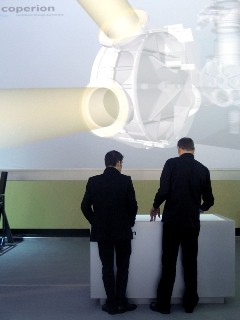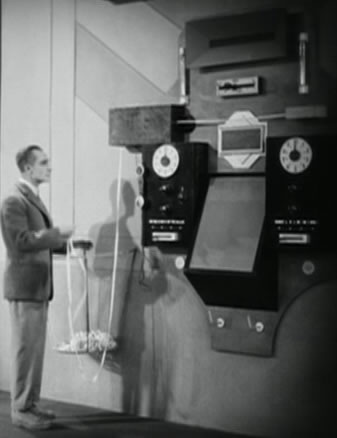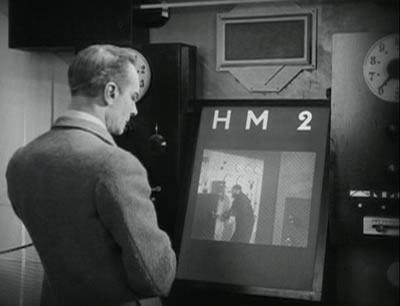Science Fiction
Dictionary
A B C D E F G H I J K L M N O P Q R S T U V W X Y Z
Multi-Touch Table For Factory Inspection

The Fraunhofer Institute in Germany has designed a multi-touch table that allows engineers to inspect virtual factories. The large touch screen display permits users to see processes in progress.

(Fraunhofer IGD multi-touch display)
A camera records the movements of the users; vision-based software tracks their fingers. Images can also be projected in front of the multi-touch screen's users.
Using multitouch input on the one hand and 3D data visualisation on the other, a user now can almost touch the 3D content and seamlessly interact with it. Thus, the Touchtable itself becomes an incredible and unique tool for the presentation and explanation of advanced processes along the value chain of plant engineering and construction: Plant elements are selected by simply touching them. Once selected, these components can be rotated in almost 360 degrees and continuously be zoomed and regarded as close as possible. Never before, one could have such an incredible and phenomenal insight.
However, there is a much older example from the classic 1927 silent film Metropolis, by Fritz Lang. In the film, vast factories and production facilities are controlled from a single "desk."

(Metropolis control "desk")
Using this device, the controller could bring up any factory floor or area, and place a call to the foreman. Various parameters about that area were also presented.

(Metropolis control center detail)
Microsoft has a recently introduced device that is somewhat similar - The DigiDesk. Take a look at the Microsoft DigiDesk prototype in action in the YouTube video below.
(Microsoft DigiDesk)
Don't miss the previously mentioned views of the Minority Report multi-touch display plus some data-tile computer display technology.
Via Virtual factories under your fingers.
Scroll down for more stories in the same category. (Story submitted 1/10/2008)
Follow this kind of news @Technovelgy.| Email | RSS | Blog It | Stumble | del.icio.us | Digg | Reddit |
Would
you like to contribute a story tip?
It's easy:
Get the URL of the story, and the related sf author, and add
it here.
Comment/Join discussion ( 0 )
Related News Stories - (" Display ")
iPhone Air Fulfils Jobs' Promise From 2007 - A Giant Screen!
'... oblongs were all over the floor and surfaces.' - Kazuo Ishiguro, 2021.
Transparent 4K OLED Wireless TV From LG
You will note that HG Wells also figured out the aspect ratio of the future!
DOTPad Braille Device Offers Live Access
Amazing tactile display.
Transparent MicroLED Screen From Samsung
Has Samsung nailed the Look of Things To Come?
Technovelgy (that's tech-novel-gee!) is devoted to the creative science inventions and ideas of sf authors. Look for the Invention Category that interests you, the Glossary, the Invention Timeline, or see what's New.
Science Fiction
Timeline
1600-1899
1900-1939
1940's 1950's
1960's 1970's
1980's 1990's
2000's 2010's
Current News
Natural Gait With Prosthetic Connected To Nervous System
'The leg was to function, in a way, as a servo-mechanism operated by Larry’s brain...'
Woman Marries Computer, Vonnegut's Dream Comes True
'Men are made of protoplasm... Lasts forever.'
Spidery 'Walk Me' Toyota Autonomous Wheel Chair Like Star Wars
Walk along with the emperor.
Dancing Robots Taught Dance Moves
'A clockwork figure would be the thing for you...'
Proof Of Robothood - Not A Person
'Who are you people? - Show 'em.'
Indonesian Clans Battle
'The observation vehicle was of that peculiar variety used in conveying a large number of people across rough terrain.'
The 'Last Mile' In China Crowded With Delivery Robots
Yes, it's a delivery robot. On wheels.
Tornyol Microdrone Kills Mosquitoes
'The real border was defended by... a swarm of quasi-independent aerostats.'
PLATO Spacecraft, Hunter Of Habitable Planets, Now Ready
'I ... set my automatic astronomical instruments to searching for a habitable planet.'
Factory Humanoid Robots Built By Humanoid Robots
'...haven't you a section of the factory where only robot labor is employed?'
iPhone Air Fulfils Jobs' Promise From 2007 - A Giant Screen!
'... oblongs were all over the floor and surfaces.'
ChatGPT Now Participates in Group Chats
'...the city was their laboratory in human psychology.'
iPhone Pocket All Sold Out!
'A long, strong, slender net...'
Did The Yautja Have These First?
What a marvel of ingenuity the little device was!
Jetson ONE Air Races Begin, Can Air Polo Be Far Behind?
'If you're one of those rarities who haven't attended a rocket-polo "carnage", let me tell you it's a colorful affair.'
Will Space Stations Have Large Interior Spaces Again?
'They filed clumsily into the battleroom, like children in a swimming pool for the first time, clinging to the handholds along the side.'
